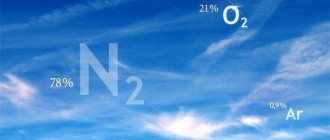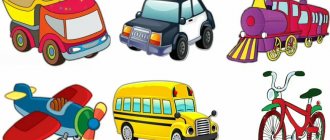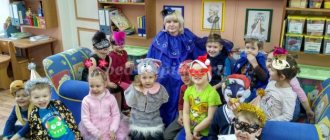SUMMARY OF AN OPEN CLASS. "Invisible air."
Transcript
1 MUNICIPAL BUDGET PRE-SCHOOL EDUCATIONAL INSTITUTION CHILD DEVELOPMENT CENTER KINDERGARTEN 12 “ORLENOK”. SUMMARY OF AN OPEN LESSON on cognitive development in the middle group on the topic: “Invisible air.” Completed by: teacher of group 8 “Ants” Shomnikova Yu.O. Lobnya, 2015
2 Integration of educational areas: cognitive development, socio-communicative development, physical development. Objectives: 1. To form children’s understanding of the importance of air for humans and all living things. 2. Continue to introduce children to the properties of air (invisible, odorless, can move, takes up space, etc.) and ways to detect it. Develop cognitive activity in the process of experimentation. 3. Cultivate a friendly attitude, a desire to help each other in game situations, and respect for the air. Aids and materials: plastic bags, toothpicks, containers of water, plastic cups, cocktail straws (according to the number of children), symbol cards, soap bubbles, parachute fabric, pointer, eau de toilette with a floral scent, a picture about air pollution. Form of implementation: subgroup. Progress: 1. Org. air game “Parachute” Educator: Guys, I have a surprise prepared for you. Look how big my piece of fabric is. It is light, airy, obedient to the air. Do you know who skydivers are? What opens up above their heads when they jump from a plane? Let's try to make a parachute, let's all stand in a circle and grab the edges. Together we all stood in a circle, We will make a parachute. We follow each other, We carry the Parachute in our hands. We all raise our hands up and inflate our parachute. This is our parachute, inflated with light air. Educator: What helped us inflate our parachute? (air) - Watch the parachute fill with air. This helps the skydiver land slowly and smoothly without hitting the ground. - Guys, let's turn into real scientists and conduct experiments to find out the secrets of the air. Do you agree? (children put on hats) - Where else do you think the air is? Children: He is everywhere (he is everywhere: on the street, in the room, in the ground, in the water and even inside us). Educator: Have you ever seen air? (No). Why don't we see him? (it is transparent, colorless, invisible). Educator: How can we check if he is in our group? (assumptions)
3 Educator: And I suggest catching with the help of bags (hands out bags to the children, the children, at the same time as the teacher, open the bags, make a movement with them and abruptly close them with their hands). — What happened to the packages? (they puffed up, looking like a pillow) - What is in them? (air) - Guys, do you know which objects also contain air? (ball, wheel, inflatable ring, mattress, armbands, ball, inflatable toy.) - How can you check whether there is really air in the bag? Take a sharp stick and carefully pierce the bag. Let's bring it to our face and press it with our hands. What do you feel? (breeze, air flows) Wind is the movement of air. - So we discovered the first secret of air: (air cannot be seen, but it can be felt). - Well done! I want to tell you that scientists write down the results of their research. For what? Let us do this with the help of pictures of symbols. - The air is transparent, it has no color, it is invisible, and we will denote this property of it with this card. (“crossed out colored spot”) (a symbol card is placed on the board) - Now let’s go and take our jobs in our laboratory. Experience "What's in the glass?" - Guys, look what's in my hand? (glass) - Is there anything in it? (no, it's empty) - Let's check. Let's turn the glass upside down and slowly lower it into the water. (must be kept level). — Does water get into the glass? (no) - We take out a glass. Look, the outside of the glass is wet, but what about the inside? (children touch the glass) Children: Dry! — Why did the glass remain dry? (there was air in the glass and it did not let water in). - Now, let’s tilt the glass a little and try to lower it into the water again. What's happening? (air comes out of the glass, and water takes its place). - That's right, water gradually displaces the air from it, taking its place. Well done, they also discovered the second secret of air (there is air inside objects, even if they seem empty). - Let's record our observations using this card. (“empty glass”) - Do you think there is air in a person? (children's answer options) Experiment “Air in a person” (children sit at tables, there are cups of boiled water and straws on the tables) - Place the straw in a glass of water and blow into it. What's happening? (bubbles come out) - Why did the bubbles appear? (air comes out) - You see, it means there is air inside us. We blow into the tube and he comes out. But in order to blow again, we first inhale a new breath of air, and
4 Then we exhale through the tube and bubbles appear. So we learned the third secret of air. - Let's write down the results of the experiment using a card. (“image of a person”) - Now let’s rest a little, let’s play with the breeze. Physical education lesson The wind blows in our faces (waves our arms) The tree sways (we sway) The wind gets quieter, quieter, (we crouch) The tree gets higher, higher (we rise on our tiptoes). “Does the air have a smell?” — Guys, while we were playing, I had a question: “Does the air have a smell?” (children's answer options) - How can we check this? (sniff the air) - Let's try to suck in air through our nose. Does it smell? Fourth secret: Air has no smell. (“nose”) Invite to stand in a circle and turn away, spray. - Guys, can you feel the smell in our laboratory? What smells? (the teacher sprays toilet water unnoticed by the children) - But where did the smell come from? Did we just find out that air has no smell? (the smell reached us) It turns out that air can move and can bring various smells to our noses. What might the air smell like? Are any smells reaching our group? (flowers, food being prepared in the kitchen, smoke from a fire, perfume, washing powder from the laundry, etc.). -Can we see the movement of air? (answer options) - Air movement is clearly visible in windy weather, because. wind is the movement of air (trees sway, grass bends, clouds float quickly, a curtain is in the wind). We learned the fifth secret (air can move). - Let's write it down using this card. (“a tree swaying in the wind”) - Dear scientists, we talked so much today about the properties of air, but we said nothing about the importance of air for humans and all living things. —Can a person live without air? Experiment “I can’t breathe” - Close your mouth and pinch your nose with two fingers. (pause) - Why did you remove your hand and open your mouth? (started to choke) - What were you missing? (air) - Did you feel good without air? (no, a person will die without air) D/i “Who needs air” Educator: Guys, let’s remember who else needs air?
5 (Large card with a picture of air, small cards with a picture of living and inanimate nature. Children lay out small cards in a circle and name who needs air). -Who needs air? How can this be called in one word? (wildlife or all living things) Why is air needed? (breathe, grow, live). The sixth secret of air. Let’s add one more to our notes: “Every living thing needs air.” — In our laboratory, guys, I found a painting. - Look what's happening to the air? (plants and factories pollute the air, cars pollute the air with exhaust gases, forest fires, people pollute the air by setting up various landfills). - Can we take care of the cleanliness of the air? (don’t light fires, don’t litter, drive serviceable cars, water the roads in the summer, plant as many flowers and trees as possible, because they purify the air, they release oxygen, clean air). — That’s right, that’s why we need to take care of our planet, take care of the cleanliness of the air and not pollute it. Generalization of knowledge about air using cards and symbols: - Our research is completed for today, let’s go to the board and remember from our notes (cards) everything that we have learned about air. Summary of the GCD: - Dear scientists, you all did a great job in the laboratory and learned a lot of new and useful things about the air, and I have prepared gifts for you. - What is this? (blows a bubble) - What's inside them? (air) - Let’s take one jar with us for a walk and watch how the breeze plays with them, whether the bubbles freeze on the street. - Now you can play with bubbles: If you blow harder, there will be a lot of bubbles! One, two, three, four, five, No way to catch them.
Summary of GCD in the middle group “Experiments with air”
Elena Savchenko
Summary of GCD in the middle group “Experiments with air”
Purpose: to give an idea that air takes up space and has properties (invisible, light, odorless), and also to give an idea that wind is the movement of air.
Tasks:
1. Educational:
- bring to the understanding that there is air around us and inside us;
- promote mastery of some methods of air detection;
- promote the formation of cognitive interest in children;
- generalize and clarify previously acquired knowledge about the properties of air;
- develop the ability to work in a team and individually during experiments.
2. Developmental:
- develop curiosity, observation, mental activity;
- develop thinking, memory, speech, interest in experimental activities.
3. Educational:
- cultivate interest and desire to expand your horizons;
— cultivate curiosity, mutual assistance, and respect for the environment;
- cultivate a positive attitude towards the world around us, a desire to explore it in all available ways.
Integration of educational areas: “Social and communicative development”, “Speech development”, “Cognitive development”, “Artistic and aesthetic development”, “Physical development”.
Modern educational technologies: health-saving, personality-oriented, problem-searching, information and communication, gaming.
Equipment and materials: plastic bags, cups of water, cocktail sticks, soap bubbles - according to the number of children; rubber, inflatable, dense and hollow toys; trays – 2 pieces; foam boats with paper sails; basins with water; fans (according to the number of children); signs with the name of the experiments.
Preliminary work:
— observation of the wind;
— conducting experiments proving the lightness of air;
— experiments with water and objects made of metal, plastic, stone, glass, sand;
- production of boats with sails, fans.
Vocabulary work: young ecologists, laboratory, transparent, invisible, experiments.
PLAN:
Educator.
Guys, I’ll tell you a riddle, listen carefully and guess it.
We need him to breathe
To inflate the balloon.
With us every hour,
But he is invisible to us!
What is this?
Children.
Air!
Educator.
That's right, it's air! Today we will talk about air. Let's do experiments like real scientists. To do this, I invite you to our “Young Experimenters” laboratory.
The children go to the laboratory.
Educator.
We are going to do experiments with air. Where is he? Guys, can't you see the air around us?
Children.
No, we don't see him.
Educator.
Since we don’t see it, what kind of air is it?
Children.
The air is transparent, invisible, colorless.
Educator.
Yes, the air is transparent, colorless and invisible. But I know that there is air and it is always around us. You can see this for yourself.
Experience No. 1
Educator.
Take a plastic bag. What's in it?
Children.
It's empty.
Educator.
It can be folded several times. Look how thin he is. We fill our bag with air and twist it. The bag is full of air, it looks like a pillow. The air took up all the space in the bag. Now let's untie the bag and let the air out of it. The package became thin again. Why do you think?
Children.
There is no air in it.
Educator.
Our conclusion: the air is transparent. In order to see him, you need to “catch” him. And we were able to do it! We "caught" the air and locked it in a bag, and then released it.
Guys, where do you think such “locked” air is used? ( Children's guess
.) That's right, in the toys that float in our pool. There is air inside our toys, it is lighter than water, so the toys do not sink, but float.
There are toys on the table. You, the young experimenters, have a task: you need to arrange the toys on two trays: put toys that float on one tray, and toys that don’t float on the second.
Children take the toys one by one and place them on two trays.
Educator.
Well done guys, now you know that objects with air inside will float. But be careful, if water gets in and pushes air out, the item may sink.
Experience No. 2
Children move to the next table.
Educator.
The next task for young experimenters.
Turn the glass upside down and slowly lower it into the jar. The glass must be held level. What happens? Does water get into the glass? ( No,
why?
( Children's assumptions.
)
Conclusion: there is air in the glass, and it does not let water in.
Experience No. 3
Educator.
The young experimenters continue their experiments: again lower the glass into a jar of water, but now you need to hold it not straight, but slightly tilted.
What appears in the water? ( Air bubbles.
) Where did they come from?
Conclusion: there was air in the glass. The air leaves the glass and water takes its place.
Educator.
We talked about how air is everywhere.
Do you think there is air inside a person? ( Children's answers.
) Now we will check this.
Experience No. 4
Educator.
The task for young experimenters is to blow into a tube placed in a glass of water.
( Children do.
) What's happening?
( Bubbles come out
.)
Conclusion: we have air inside us. We blow into the tube and the air comes out. In order to blow again, we first inhale new air and then exhale through the tube, thus creating bubbles.
Educator.
Guys, what other bubbles can you blow?
Children.
Soapy.
Educator.
I suggest young experimenters blow soap bubbles.
Experience No. 5
Children blow bubbles to the music.
Educator.
They are so beautiful, colorful and light! What do you think is inside soap bubbles? Of course, each bubble contains air inside. This soap film is filled with air and comes off the loop. Light, air-filled bubbles float in the air.
Conclusion: we exhale air. This means there is air inside us.
Educator.
How does air get into us?
All people breathe through their nose. Guys, please show me how your noses breathe.
Breathing exercises are performed.
Experience No. 6
Educator.
Guys, when we just inhale and exhale air, do we see it?
( No.
) The next task is for young experimenters.
There are paper napkins in front of you. You need to take the napkin with two fingers and bring it to your mouth. We breathe evenly, calmly. ( Children do
.) Have you noticed that when we inhale and exhale air, the napkin moves like leaves on trees. We told you that the leaves sway in the wind. Where did the wind come from in our laboratory?
Conclusion: you inhaled and exhaled, the air moved, and it turned out to be a breeze. This means that when air moves, it produces wind. Do you want to make some wind?
Experience No. 7
Educator.
Here are our boats that we made in the last lesson. You remember, I promised that we would float them on water. Take each of your boats and put them in a basin of water. Slowly blow on the boats. What happens?
Conclusion: boats float. The breeze created by the flow of air from the chest inflates the sails, and the boats sail. The ships catch the air with their sails. Air can move objects.
Experience No. 8
Educator.
Guys, now we were blowing on the boats, and the air was pushing them.
And if you don’t blow, how else can you create wind? ( Children's suggestions.
)
Assignment for young experimenters: try to create wind using a fan. Wave first at yourself, then at each other. What do you feel? ( A breeze blows in my face.
) And if we wave our fans over the boats, what will happen?
Conclusion: we wave a fan, move the air, we get wind, and the boats float.
Result:
Educator.
Guys, what do you think the air smells like?
( Children's answers
.) Let's come closer to the door and smell it. What does it smell like? That's right, our chefs are preparing lunch for us.
The air moves and carries smells to our noses, although the air itself has no smell. If we open the window, a stream of fresh air will come to us. It's fresh air and easy to breathe. We will see this during our walk.
Today we learned about the properties of air. Tomorrow in class we will make an application “Travel in a Balloon”.




